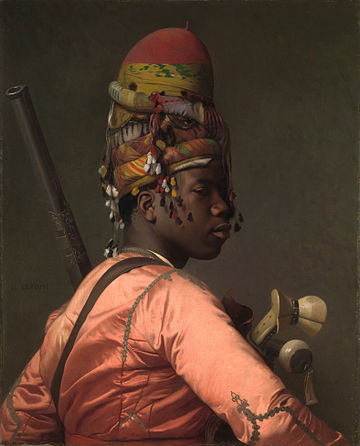Bashi-Bazouk (possibly titled Bachi-Bouzouk nègre)[1] is a painting by French artist Jean-Léon Gérôme. Done in oil on canvas, the painting depicts a Bashi-bazouk, an irregular soldier of the Ottoman Empire. The painting is currently on display at the Metropolitan Museum of Art.
| Bashi-Bazouk | |
|---|---|
| French: Bachi-Bouzouk, Bachi-Bouzouk nègre | |
 | |
| Artist | Jean-Léon Gérôme |
| Year | 1869 |
| Medium | Oil on canvas |
| Dimensions | 80.6 cm × 66 cm (31.7 in × 26 in) |
| Location | Metropolitan Museum of Art |
Description
Painted by Jean-Léon Gérôme between 1868 and 1869, the painting depicts a dark-skinned model dressed as a Bashi-bazouk, a levy of irregular Ottoman soldiers infamous for their brutality, looting, and lack of discipline.[2] Gérôme acquired the garb seen in the painting during a trip to the near east in 1868. The haphazard and mixed textiles the model is dressed in is reminiscent of the Bashi-bazouks, as the soldiers were traditionally unpaid and did not adopt a standardized uniform, resulting in the soldiers wearing whatever they could acquire on a march. This a key point of the painting, as the brutal reputation of a Bashi-bazouk is contrasted by the silk tunic, quality clothes, and noble bearing of the subject.[3]
References
Wikiwand in your browser!
Seamless Wikipedia browsing. On steroids.
Every time you click a link to Wikipedia, Wiktionary or Wikiquote in your browser's search results, it will show the modern Wikiwand interface.
Wikiwand extension is a five stars, simple, with minimum permission required to keep your browsing private, safe and transparent.
